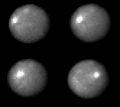Archivo:Ceres Rotation.jpg

Tamaño de esta previsualización: 676 × 600 píxeles. Otras resoluciones: 270 × 240 píxeles | 541 × 480 píxeles | 880 × 781 píxeles.
Archivo original (880 × 781 píxeles; tamaño de archivo: 94 kB; tipo MIME: image/jpeg)
Historial del archivo
Haz clic sobre una fecha y hora para ver el archivo tal como apareció en ese momento.
| Fecha y hora | Miniatura | Dimensiones | Usuario | Comentario | |
|---|---|---|---|---|---|
| actual | 07:53 30 ene 2006 |  | 880 × 781 (94 kB) | Arnomane | higher resolution |
| 13:17 9 sep 2005 |  | 300 × 300 (4 kB) | Vesta~commonswiki | {{Information| |Description = NASA's Hubble Space Telescope took these images of the asteroid 1 Ceres over a 2-hour and 20-minute span, the time it takes the Texas-sized object to complete one quarter of a rotation. One day on Ceres lasts 9 hours. The bri |
Usos del archivo
La siguiente página usa este archivo:
Uso global del archivo
Las wikis siguientes utilizan este archivo:
- Uso en ba.wikipedia.org
- Uso en be-tarask.wikipedia.org
- Uso en bs.wikipedia.org
- Uso en ca.wikipedia.org
- Uso en ca.wikinews.org
- Uso en cs.wikipedia.org
- Uso en el.wikipedia.org
- Uso en eo.wikipedia.org
- Uso en fa.wikipedia.org
- Uso en fr.wikipedia.org
- Uso en hu.wikipedia.org
- Uso en hy.wikipedia.org
- Uso en id.wikipedia.org
- Uso en it.wikipedia.org
- Uso en ja.wikipedia.org
- Uso en ka.wikipedia.org
- Uso en ko.wikipedia.org
- Uso en mk.wikipedia.org
- Uso en mwl.wikipedia.org
- Uso en nl.wikipedia.org
- Uso en no.wikipedia.org
- Uso en oc.wikipedia.org
- Uso en ru.wikipedia.org
- Uso en sk.wikipedia.org
- Uso en te.wikipedia.org
- Uso en tl.wikipedia.org
- Uso en zh.wikipedia.org

